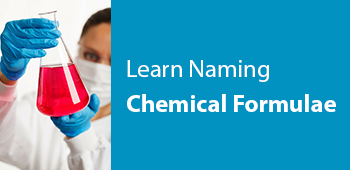
SHARING IS CARING
If our Website helped you a little, then kindly spread our voice using Social Networks. Spread our word to your readers, friends, teachers, students & all those close ones who deserve to know what you know now.
How to learn naming Chemical Formulae?
1. A formula is a shorthand notation used to identify the composition of a molecule or compound.
2. For example chemical formula of water is H2O. It includes the symbol of each element (e.g. Hydrogen:H and Oxygen:O) in the molecule, along with numerical subscripts to show how many atoms of each element are present.
3. Most of the inorganic compounds are binary compounds i.e. it consists of two elements. Some are ternary i.e. contain more than two elements.
4. Compounds may be ionic compounds i.e. elements have ionic bonds. Or these can be covalent bonded. Generally, metal element forms ionic bond with non-metal element. Compounds having non-metals only have covalent bonding.
5. An atom or group of atoms with either a positive or a negative charge is called an Ion
6. Cations are positively charged ions.
7. Anions are negatively charged ions (Are Negative IONS)
8. Monatomic Ion means a single atom ion (mono = one) Ex: Na+ or Cl-
9. Polyatomic Ion means a group of atom ions (poly means many) which acts together as single unit. For example: Nitrate polyatomic ion NO3- (1 Nitrogen atom, 3 Oxygen atoms has one extra electron and thus is negatively charged 1-).
10. For binary compounds containing a metal and a non-metal, metal is always named first, followed by a name derived from the root name for the nonmetal. E.g. Common Salt NaCl consists metal (cation: Na+) and non-metal Chlorine becomes chloride here (anion: Cl-)
11. Usually anions of an element carrying one negative charge (1-) have suffix -ide
| Element Anion | Name used in formula |
|---|---|
| Cl- | Chloride |
| F- | Fluoride |
| Br- | Bromide |
| I- | Iodide |
| O2- | Oxide |
| S2- | Sulphide |
| H- | Hydride |
| Au- | Auride |
| N3- | Nitride |
| P3- | Phosphide |
| As3- | Arsenide |
12. The net charge on an ionic compound is always zero. E.g. In NaCl, one cation(Na1+) and one anion(Cl1-), makes the net charge (1+ + 1- = 0) zero. Similarly, in AlCl3. one cation (Al3+ ) and three anions (Cl1-), makes the net charge(3+ + 3(1-)= 0) zero.
13. Anions carrying oxygen+another element are called -oxy anions. In general, for -oxy anions we use suffix -ate is used. Few examples are:
| -oxy Anion | Name used in formula |
|---|---|
| CO32- | Carbonate |
| SO42- | Sulphate |
| SiO32- | Silicate |
| ZnO32- | Zincate |
14. In case of -oxy anions, if non-metal element exists with oxygen in more than one charged (or oxidation) state, then we use suffix -ite for the lower charged state and -atefor higher charged state.
| -oxy Anion | Name used in formula |
|---|---|
| SO32- | Sulphite |
| SO42- | Sulphate |
| NO2- | Nitrite |
| NO3- | Nitrate |
| SnO22- | Stannite |
| SnO32- | Stannate |
15. In case of -oxy anions, if more than two oxidation (charged) states exist, we use the following naming convention (Note: It is old traditional system, still in use. IUPAC time to time releases new nomenclature standards).
| Oxidation State | prefix- or -suffix used in Anions |
|---|---|
| Lowest | Hypo- -ite |
| . | -ite |
| . | -ate |
| . | per- -ate |
| Highest | Hyper- -ate |
An example of this:
| -oxy Anion | Name used in formula |
|---|---|
| ClO- | Hypochlorite |
| ClO2- | Chlorite |
| ClO3- | Chlorate |
| ClO4- | Perchlorate |
| HPO32- | Phosphite |
| H2PO2- | Hypophosphite |
16. When an polyatomic anion has H- associated with it, we use bi- or hydrogen- as suffix root name.
For example,
| Polyatomic Anion with H- |
Name used in formula |
|---|---|
| HCO3- | bicarbonate or hydrogen carbonate |
| HSO4- | bisulphate or hydrogen sulphate |
| HSO3- | bisulphite or hydrogen sulphite |
| HS- | bisulphide or hyderogen sulphide |
| HPO42- | monohydrogen phosphate |
| H2PO4- | dihydrogen phosphate |
(Note: to represent number of atoms, prefixes like mon-, bi-, di-, tri- etc. are used).
17. List of a few other polyatomic anions
| Polyatomic Anions | Name used in formula |
|---|---|
| OH- | Hydroxide |
| O2- | Superoxide |
| O3- | Ozonide |
| NH2- | Amide |
| N3- | Azide |
| CN- | Cyanide |
| OCN- | Cyanate |
| SCN- | thiocynate |
| CrO22- | Chromate |
| Cr2O72- | DiChromate |
| MnO42- | Manganate |
| MnO4- | Permangnate |
| CH3COO- | Acetate |
| C2O42- | Oxalate |
| PO43- | Phosphate |
18. List of Cations whose charge do not vary
| Single Charge | Double Charge | Triple Charge | |||
|---|---|---|---|---|---|
| Hydrogen | H+ | Beryllium | Be2+ | Aluminium | Al3+ |
| Lithium | Li+ | Magnesium | Mg2+ | ||
| Sodium | Na+ | Calcium | Ca2+ | ||
| Potassium | K+ | Strontium | Sr2+ | ||
| Cesium | Cs+ | Barium | Ba2+ | ||
| Rubidium | Rb+ | Zinc | Zn2+ | ||
| Silver | Ag+ | Cadmium | Cd2+ | ||
| Ammonium | NH4+ |
19. Following is the list of cations whose charges vary. In traditional system, we use suffix -ous with lower charged state and -ic withhigher charged state. The new IUPAC method, the charged state is represented with Roman numerals within parentheses.For example:
| Element | Cation | IUAPC Name | Tradional Name | Example |
|---|---|---|---|---|
| Copper | Cu+ | Copper(I) | Cuprous | |
| Copper | Cu2+ | Copper(II) | Cupric | |
| Gold | Au+ | Gold(I) | Aurous | AuCl Gold(I) Choloride or Aurous Chloride |
| Gold | Au3+ | Gold(III) | Auric | AuCl3 Gold (III) Chloride or Auric Chloride |
| Iron | Fe2+ | Iron(II) | Ferrous | |
| Iron | Fe3+ | Iron(III) | Ferric | |
| Mercury | Hg+ | Mercury(I) | Mercurous | |
| Mercury | Hg2+ | Mercury(II) | Mercuric | |
| Chromium | Cr2+ | Chromium(II) | ||
| Chromium | Cr3+ | Chromium(III) | ||
| Chromium | Cr6+ | Chromium(VI) | ||
| Cobalt | Co2+ | Cobalt(II) | ||
| Cobalt | Co3+ | Cobalt(III) | ||
| Manganese | Mn2+ | Manganese(II) | ||
| Manganese | Mn3+ | Manganese(III) | ||
| Manganese | Mn7+ | Manganese(VII) |
20. In some cases cations containing non-metals, we use suffix -nium
For example:
| Cations | Name used in formula |
|---|---|
| NH4+ | Ammonium |
| NH2H5+ | Hydrazinium |
| C5H6N+ | pyridinium |
| H3O+ | Hydronium |
| NO2+ | Nitronium |
21. Acid is any substance that has one or more replaceable hydrogen ions (H+).
22. Acids which do not contain oxygen are named with prefix hydro-
A few examples are:
| Acid | Name |
|---|---|
| HF | Hydroflouro acid |
| HCl | Hydrochloric acid |
| HBr | Hydrobromic acid |
| HI | Hydroiodic acid |
| HCN | Hydrocyanic acid |
| H2S | Hydrosulphuric acid or Hydrogen Sulphide (Do not confuse with Sulphuric acid H2SO4) |
| HN3 | Hydrazoic acid |
23. List of acids which contain oxygen.
| Acid | Name |
|---|---|
| H2CO3 | Carbonic acid |
| H3CO3 | Boric acid |
| H4SiO4 | Silicic acid |
| HNO3 | Nitric acid |
| HNO2 | Nitrous acid |
| H2SO4 | Sulphuric acid |
| H2SO3 | Sulphurous acid |
| H2S2O3 | Thiosulphuric acid |
| H2CrO4 | Chromic acid |
| H2Cr2O7 | Dichromic acid |
| H3PO4 | Phosphoric acid |
| H3PO3 | Phosphorous acid |
| H3AsO4 | Arsenic acid |
| H3AsO3 | Arsenious acid |
| HClO4 | Perchloric acid |
| HClO3 | Chloric acid |
| HClO2 | Chlorous acid |
| HClO | Hypochlorous acid |
| HMnO4 | Permanganic acid |
| HOCN | Cyanic acid |
| HSCN | Thiocyamc acid |
| CH3COOH | Acetic acid |
| H2C2O4 | Oxalic acid |
Q1: Write the chemical formula of the following. List the cations and anions present.
(a) sodium chloride
(b) potassium iodide
(c) calcium sulfide
(d) cesium bromide
(e) magnesium oxide
Answer:
(a) sodium chloride: NaCl (Na+, Cl-)
(b) potassium iodide: KI (K+, I-)
(c) calcium sulfide: CaS(Ca2+, S2-)
(d) cesium bromide: CsBr (Cs+, Br-)
(e) magnesium oxide: MgO (Mg2+, O2-)
Q2: Name the following binary compounds.
(a) AlCl3
(b) CsF
(c) MgI2
(d) CaCl2
(e) LiCl
(f) MgS
(g) Rb2O
(h) CaO
Answer:
(a) AlCl3: Aluminium Chloride
(b) CsF : Cesium Fluoride
(c) MgI2: Magnesium Iodide
(d) CaCl2: Calcium Chloride
(e) LiCl : Lithium Chloride
(f) MgS : Magnesium Oxide
(g) Rb2O : Rubidium oxide
(h) CaO: Calcium Oxide
Q3: Give chemical formula for the following compounds.
(a) iron (III) Chloride
(b) ferric oxide
(c) sodium hydroxide
(d) cobaltous hydroxide or cobalt(II) hydroxide
(e) tin (IV) Hydroxide
(f) mercuric cyanide
Answer:
(a) iron (III) Chloride: FeCl3:
(b) ferric oxide: Fe2O3
(c) sodium hydroxide: NaOH
(d) cobaltous hydroxide or cobalt(II) hydroxide: Co(OH)2
(e) tin (IV) hydroxide: Sn(OH)4
(f) mercuric cyanide: Hg(CN)2
Q4: Give chemical formula for the following compounds:
- Potassium chlorite
- Magnesium sulphite
- Chromium sulphate
- Sodium acetate
- Lead chloride
- Cuprous iodide
- Copper(II) sulphide
- Ferric chlorite
- Mercuric chloride
- Barium peroxide
- Strontium silicate
- Cobalt (III) nitrate
- Lithium hydride
- Ammonium cyanate
- Strontium manganate
- Silver oxalate
- Calcium phosphide
- Radium phosphate
- Aluminium nitride
- Zinc nitrate
Answer(incomplete):
- Potassium chlorite : KClO2
- Magnesium sulphite: MgSO3
- Chromium (III) sulphate: Cr2(SO4)3
- Sodium acetate: CH3COONa
- Lead chloride: PbCl2
- Cuprous iodide: CuI
- Copper(II) sulphide: CuS
- Ferric chlorite: Fe(ClO2)3
- Mercuric chloride: Mercury(II) Chloride - HgCl2
- Barium peroxide: BaO2
- Strontium silicate
- Cobalt (III) nitrate
- Lithium hydride
- Ammonium cyanate
- Strontium manganate
- Silver oxalate
- Calcium phosphide
- Radium phosphate
- Aluminium nitride
- Zinc nitrate







 Profile
Profile Signout
Signout














 Quiz
Quiz
 Get latest Exam Updates
Get latest Exam Updates 










